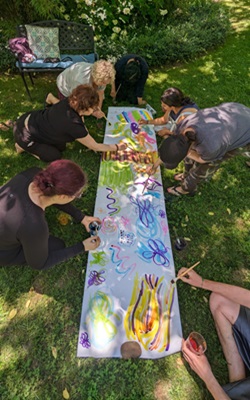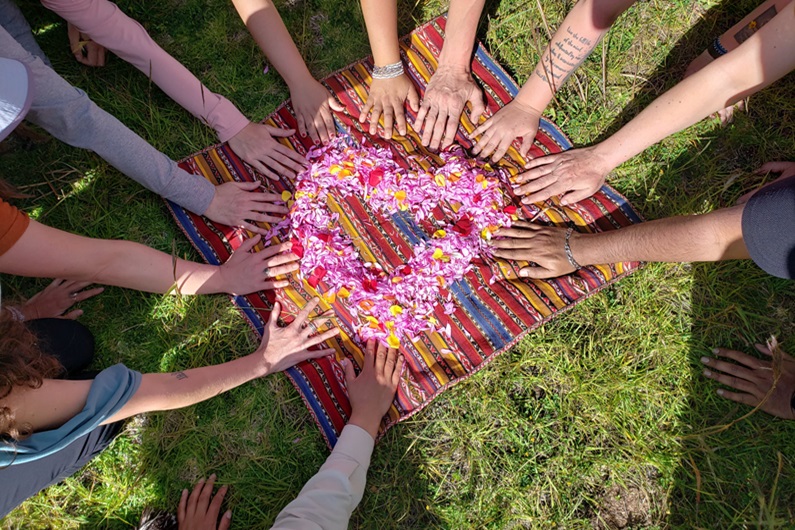In today’s world, we’re exposed to an unprecedented level of collective trauma, resulting in significant collective grief as highly sensitive people. As deep feelers, we may hesitate to acknowledge the grief we feel about issues that seem beyond our control, fearing emotional overwhelm. However, avoiding or suppressing our emotions can lead to greater distress and hinder our ability to take meaningful action.
Understanding Collective Grief
Collective grief is the emotional response that emerges when large groups of people experience a common loss or trauma, such as a climate disaster or social injustice. Unlike personal grief, which an individual feels after a personal loss, collective grief affects communities and societies.
Feeling collective grief as highly sensitive people can be challenging. Our deep empathy and emotional processing mean that we feel the world’s suffering intensely. Yet, being able to sit with the pain of others serves as a powerful reminder of our shared humanity.
Collective grief plays a crucial role in societal healing, reminding us that our emotional responses are not isolated. When communities grieve together, they create space for shared understanding and support, which leads to stronger, more resilient societies.
The Work That Reconnects: A Framework for Collective Grief
The Work That Reconnects (WTR), developed by environmental activist Joanna Macy, offers a powerful framework to respond to our current social and ecological challenges. I believe this model can be particularly helpful for highly sensitive people.
Recognizing widespread despair about the climate crisis, and intersecting justice issues, WTR provides a path to embrace grief and build resilience. It does this through practices designed to reconnect us with ourselves, humanity, and the non-human world, fostering belonging and strength. When we recognize our interconnectedness, we’re more empowered to act on behalf of life.
Four Stages of the Work That Reconnects Spiral
WTR follows a spiral process to continually deepen our ability to be with pain and respond effectively.
1) Gratitude: The spiral begins with gratitude, acknowledging the beauty and interconnectness of all life. Grounding in gratitude strengthens our foundation and resources to face pain and grief. We also tap into a deeper satisfied self, liberating ourselves from the grip of systems that tell us we’re inadequate.
2) Honoring Our Pain: This involves recognizing our pain for the world and becoming aware of our reactions. Feelings of sorrow or anger are normal, healthy reactions to collective trauma and suffering. Experiencing our grief with others can enable us to feel solidarity.
3) Seeing with New and Ancient Eyes: Here we recognize that our collective grief stems from our intimate ties to all life. Through contemporary and ancestral wisdom, we gain a clearer view of our place in the web of life. We situate ourselves within deep time, an expansive perspective that links us with past and future generations. This means releasing the need for immediate outcomes and committing to life-sustaining actions that go far beyond our lifetimes.
4) Going Forth: This stage harnesses our resilience developed in earlier stages to move from inner work to outward action. It involves identifying your role and methods for contributing to collective healing and cultural transformation, based upon your unique strengths, skills, and where you’re called.
Practical Application for Collective Grief as HSPs
 WTR is woven into many of the nature-based expressive arts and ecotherapy practices that I facilitate in retreats and online circles. During a recent retreat in North Carolina, I invited participants to engage in practices designed to help them embrace emotional pain and collective grief as highly sensitive people—without getting stuck in it. These practices included gratitude, a grief ritual, interactive nature connection, embodied movement, and collective art.
WTR is woven into many of the nature-based expressive arts and ecotherapy practices that I facilitate in retreats and online circles. During a recent retreat in North Carolina, I invited participants to engage in practices designed to help them embrace emotional pain and collective grief as highly sensitive people—without getting stuck in it. These practices included gratitude, a grief ritual, interactive nature connection, embodied movement, and collective art.
Initially, most were hesitant about the grief ritual. Some opted out, which was just fine. Naturally, those who did participate expressed sorrow and heaviness when we debriefed this practice.
Yet, in the end, everyone agreed that naming their grief was important. Furthermore, they were surprised by how the subsequent practices significantly shifted their moods and perspectives. They all reported feeling something along the lines of lighter, hopeful, connected, or empowered.
Applying This Work in Your Own Life
If you’re a highly sensitive person struggling with collective grief, consider incorporating these practices into your life.
Perhaps you spend a moment grounding in gratitude before reading the news. Maybe you set aside time each week, alone or with a loved one, allowing your collective grief to flow freely. Or maybe you join a community of people with similar struggles and build meaningful connections.
All of our HSP and Introvert Retreats offer a space to build meaningful connections. However, if you’re interested in a retreat that incorporates the Work That Reconnects and other ecotherapy practices, I invite you to take a look at our upcoming Georgia Retreat for Sensitive and Introverted Women (November 7-12, 2024).
To learn more about the Work That Reconnects, I recommend these books by Joanna Macy:
- Coming Back to Life: The Updated Guide to the Work That Reconnects by Joanna Macy & Molly Brown
- Active Hope: How to Face the Mess We’re in With Unexpected Resilience and Creative Power (Revised Edition) by Joanna Macy & Chris Johnstone
By embracing your nature as a feeler, you can create a nurturing space to experience your grief. The gifts of highly sensitive people are needed now. With supportive tools and community, we can transform our pain into meaningful, life-giving action.


Seeking Meaningful Travel Without the Overwhelm?
Success! Look for my welcome email in your inbox. If you don't see it, check your SPAM!